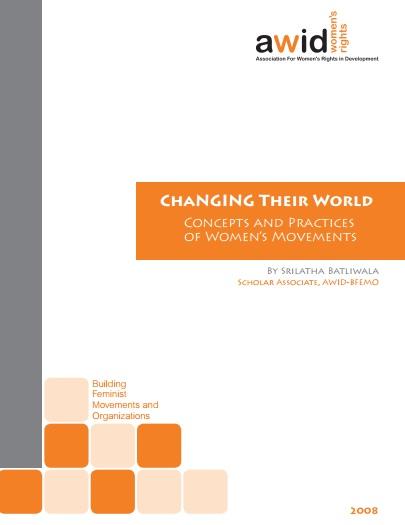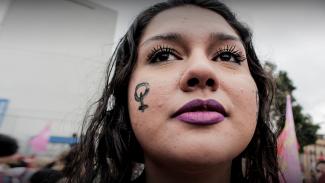
This compilation of case studies highlights the origins, structures, strategies, and impacts of various women's movements around the world.
We undertook a series of 14 case studies from different regions of the world that have mobilized women to make a difference. The case studies are not a full representation of current women’s movements but rather an initial effort to document an interesting variety of movement experiences.
The case studies were undertaken by researchers and advisors in different regions. A case guideline was developed to broadly obtain comparative data on the origins, structures, strategies and impacts of the movements. The studies were conducted and documented between July 2007 and February 2008.
A summary and compilation of all 14 case studies can be read online or downloaded on the right.
Each case study is also available for download below.
Women within the Indigenous Peoples’ Movement of Mexico: New Routes for Transforming Power
By Marusia López Cruz
This case study presents the history and context of the National Coordinating Committee of Indigenous Women (Coordinadora Nacional de Mujeres Indígenas, CNMI) as a way of understanding and describing the construction, agenda, and strategies of the women within the indigenous movement in Mexico.
Against All Odds: The Building of a Women’s Movement in the Islamic Republic of Iran
By Homa Hoodfar
Two decades of decentralized, informal, and semi-formal activities aimed at mobilizing women and building a robust women’s movement in Iran are presented in this case study. It also provides an analysis of the efforts of women’s advocates in the Islamic Republic of Iran.
The Dalit Women’s Movement in India: Dalit Mahila Samiti
By Jahnvi Andharia with the ANANDI Collective
The Dalit Mahila Samiti (DMS) organisation, located in the northern Indian state of Uttar Pradesh, aims to challenge the oppressive caste system specifically those considered 'untouchable'. This case study provides an analysis of the goals, strategies, and achievements of DMS
Domestic Workers Organizing in the United States
By Andrea Cristina Mercado and Ai-jen Poo
Mujeres Unidas y Activas, Domestic Workers United, and the National Alliance of Domestic Workers are three organizations fighting for domestic worker rights in the United States. This case study highlights the impact these organizations have on improving the rights of immigrants and women of colour in the United States.
Challenges Were Many: The One in Nine Campaign, South Africa
By Jane Bennett
The South African One in Nine Campaign organization's mission is to ensure that the issue of the sexual rights of all women is addressed. This case study analyses the activities of this organization in the hisotrical and current social and political context of South Africa.
Mothers as Movers and Shakers: The Network of Mother Centres in the Czech Republic
By Suranjana Gupta
The Czech Mothers Network based in the Czech Republic has created a strong political voice used to influence public policy and give priority to women as both mothers and workers. This case study provides an analysis of this organization's process and experiences.
The Demobilization of Women’s Movements: The Case of Palestine
By Islah Jad
The Palestinian Federation of Women’s Action Committees (PFWAC) and The Women’s Centre for Legal Aid and Counseling (WCLAC) are presented to illustrate how the early mass-based women’s movement has changed into the phenomenon known as the NGO-ization in Palestine.
The Piquetera/o Movement of Argentina
By Andrea D’Atri and Celeste Escati
The Argentinan-based Piquetera/o Movement and its pioneering methods are provided in this case study to highlight the tradition of the working class stuggle, the student and other social movements in Argentina.
GROOTS Kenya
By Awino Okech
GROOTS in Kenya is described and defined as a women's movement rather than a network or NGO. Along with the history and the national political dynamics of Kenya, the objectives, structures, activities, successes and voice of GROOTS that have shaped and contributed to women’s rights work in Kenya are described in this case study.
The European Romani Women’s Movement – International Roma Women’s Network
By Rita Izsak
The International Romani Women’s Network (IRWN) is the first and only registered international umbrella organization representing Romani women of all Romani groups. It seeks to address the oppression, exploitation and discrimination faced by Romani women throughout Europe. This case study presents their efforts to promote women’s rights, and examines the connection between mainstream feminist movements and the Romani movement.
The Seeds of a Movement—Disabled Women and their Struggle to Organize
By Janet Price
Since the 1970s, disabled women have been organizing and raising awareness of the oppression they face. This case study maps out the challenges that disabled women have confronted in their struggle to fight discrimination and build their own movements. It presents examples from small local groups facing specific challenges, national bodies addressing policy and law-making, and international groups like the UN to establish global rights.
GALANG: A Movement in the Making for the Rights of Poor LBTs in the Philippines
By Anne Lim
Galang is the Filipino word for respect and lies at the core of GALANG’s struggle for equality and justice which they promote in both local LGBT communities and within mainstream Philippine society. This case study contributes to global learning about feminist movements and organizing, and to the growing body of work that investigates the intersections between sexuality and poverty.
The VAMP/SANGRAM Sex Worker’s Movement in India’s Southwest
By The SANGRAM/VAMP team
This case study presents the history, formation, leadership, and function of the VAMP Collective. VAMP and SANGRAM are examples of the sex workers rights movement in India.
Women Building Peace: The Sudanese Women Empowerment for Peace (SuWEP) in Sudan
By Zaynab ElSaw
During the 1990s Sudanese women from both north and south formed the Sudanese Women Empowerment for Peace (SuWEP), an umbrella body bringing together women from the two regions, and from different ethnic, socio-economic, and political backgrounds. This case study tells the story of Sudanese women’s involvement in the peace processes before and after the initiative of SuWEP, and explores the roles SuWEP played as a feminist movement through the analysis of the tools and approaches developed by the women’s groups to make their voices heard.
